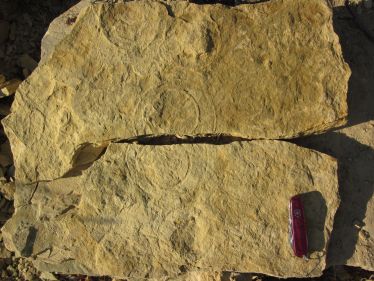It makes sense, since it was citizen scientist paleontologists that discovered the almost perfectly circular rings some 30 years ago.
Nigel Hughes, a professor of paleobiology in the Department of Earth Sciences at the University of California, Riverside, wants to know if they are the result of a physical process or the activity of an ancient organism - and a cool $500 is in it if you do what the pros cannot.
Hughes now invites the public to help solve the riddle. The project, which launched at 5 a.m., Monday, Feb. 16, will end at 4 p.m., Wednesday, March 11th. The creators have provided notes explaining the problem and guidelines for submitting entries, along with videos about the rings. The detailed information is intended to help those wishing to submit serious suggestions constrain and refine their ideas.

Both surfaces of a slab that was split open to reveal the ancient seafloor in plan view, revealing mirror images of the rings on both the upper and lower surfaces. The slab at the bottom of the picture would represent the original seafloor, with the surface shown in the upper part of the picture, which is here inverted to show its bottom side, sitting immediately on top of it. Photo credit: Hughes Lab, UC Riverside.
Participants will have a chance to vote on explanations proposed by others. The UCR team will provide feedback on credible ideas as they are proposed, providing additional details and making fresh observations as necessary.
“In the end we will decide the winner very soon after the project ends,” Hughes said. “The winner won’t necessarily be the most popular explanation, but will be the natural explanation that we think provides the best fit to the data.”




Comments